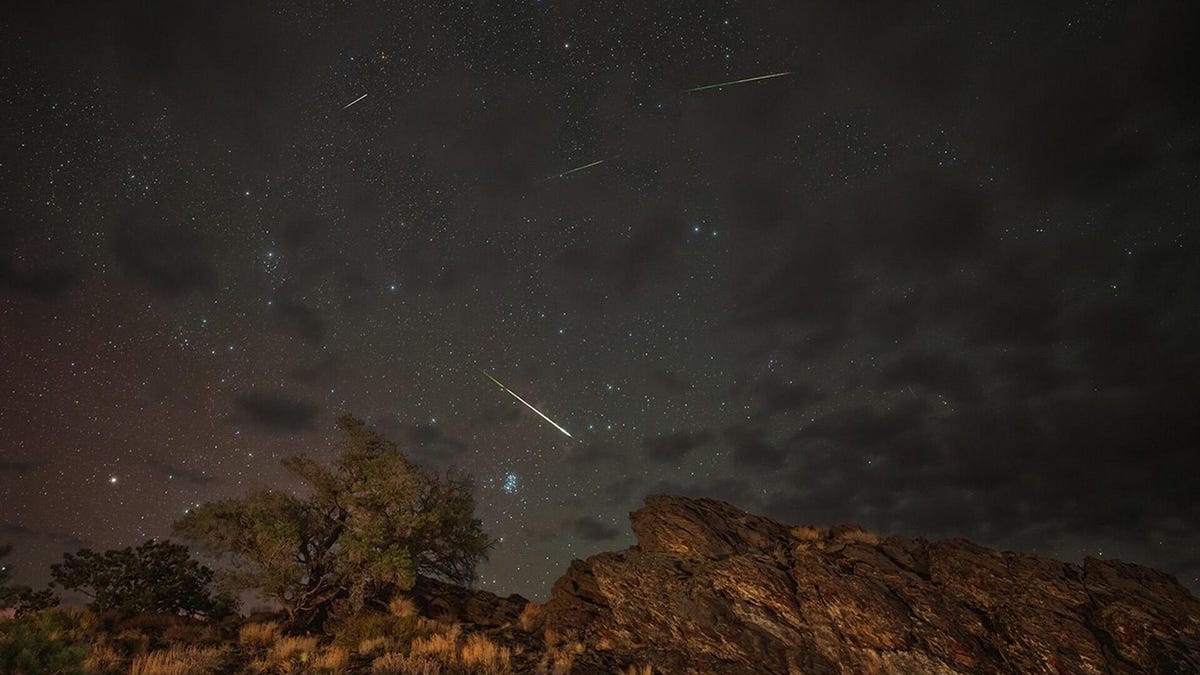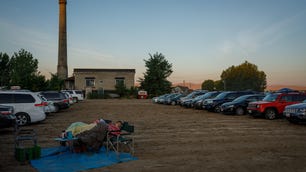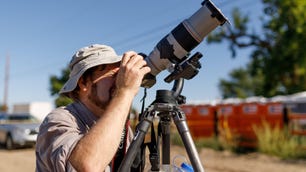Technologies
Don’t Miss Out on the Perfect Solar Eclipse Photo: Tips on Taking Pictures Today
Take these steps to minimize potential damage to your camera or phone lens, and get a great photo.

Today’s solar eclipse is the talk of the town. During its trip across North America, the total eclipse will hit parts of Mexico, a long diagonal stripe across the US and a stretch of eastern Canada. It’ll be quite the event, especially since the next total solar eclipse to hit North America won’t happen until August 2044.
Nearly half of the US population lives within a 200-mile drive of the event, giving many people a chance to catch a glimpse or a photo.
Remember, you must wear solar eclipse glasses if you’re looking up during the eclipse. While the sun will be completely hidden behind the moon for a few minutes, the rest of the eclipse will be just as harmful to human vision as it would be if you stared at the sun on any other day. So you’ll want to make sure that your solar glasses will protect your eyes while you watch.

You’ll want to protect your camera and its lenses, too, if you’re among the throngs who’ll be aiming a smartphone or DSLR at the sun in hopes of capturing that perfect image to share on social media of the last total solar eclipse in the US for the next 20 years.
Here are a few things to know before pointing your sensitive and expensive devices at the giant fireball in the sky.
Taking photos of the solar eclipse with a smartphone
A great many solar eclipse photos are likely to come from smartphones, given that just about everyone has one and that many are packed with very capable cameras.
First things first, you’ll want to pick up a solar filter. You don’t need anything fancy. You can buy little solar lenses that you can physically hold in front of your phone camera lens for a little over $10. In a pinch, you could use one of the lenses from a pair of paper solar eclipse glasses to achieve the same effect.
In general, your phone’s auto mode should take care of most of the heavy lifting. Phone makers have spent tons of time tuning the cameras to the appropriate settings to take the best possible picture. If you want to take matters into your own hands, you can always switch to manual mode — but do spend a bit of time before the eclipse familiarizing yourself with those settings.
A few other helpful tips:
- Turn off your flash. Once totality hits, you’ll be taking pictures essentially at night and your flash isn’t going to help. Plus, it can annoy people around you.
- Only use zoom if your phone is equipped with an optical zoom lens like the Galaxy S24 Ultra or the iPhone 15. Check your phone model to see if yours comes equipped with it. Using digital zoom will reduce resolution and make the image look blocky and unappealing.
- Most modern smartphones feature a burst shot mode. The crown jewel of eclipse photography, the diamond ring, is only visible for a split-second and a burst shot mode will give you better odds of capturing it than if you try to time it yourself.
- Practice. Taking good pictures of the sun is no easy task and you don’t want to spend the entire time fiddling with your smartphone camera settings.
- Google also recommends bringing a portable battery bank. Camera use is a huge battery drain, and you may need some extra juice.
Taking photos of the solar eclipse with a DSLR
Many of the rules for smartphone photography also apply if you plan on taking a DSLR or mirrorless camera to the event. The steps to get there are slightly different. Smartphones can use virtually any solar filter, but cameras require something that’ll fit on the end of your camera’s lens barrel since it’s very difficult to hold a filter while taking a picture with a regular camera.
You may think you need a UV filter for solar photography. In reality, you’ll want an ND (neutral density) filter. ND filters reduce the amount of light coming into the lens the same way solar eclipse glasses reduce the amount of light coming into your eyes. K&F Concepts has a good one designed specifically for celestial photography.
The next factor is size. Filters come in various sizes and the size you need depends on what lens you own. Check the barrel of your lens. You’ll want to find the ø symbol with a number next to it. That number is the millimeter size you need.
If your lens doesn’t have that measurement on it, you can find the measurements on the box the lens came in or on the manufacturer’s website. If you get an incorrectly sized filter, it won’t fit on your camera properly, so make sure you look before you leap since ND filters can get quite expensive.
Once you obtain a solar filter, the same general tips apply to a regular camera. Practice photographing the sun over the weekend before the eclipse so you can dial in your preferred settings. Use burst mode to capture the diamond ring, bring spare batteries, and make sure your equipment is in order before the event.
Camera owners may also want to consider bringing multiple lenses to get different types of pictures, and you should definitely bring a tripod if you’re planning on long exposure shots, or just for stability in general. (A remote shutter release helps as well.) If you’re comfortable with it, shooting in raw image format can also produce some amazing results after some editing.
Can I take photos of the solar eclipse without a filter?
Human eyes can be damaged in seconds when staring at the sun — and the same is true for eyes looking through an unprotected camera lens at the eclipse. Camera lenses themselves are a bit more resilient. They might be able to handle the occasional sun photograph, but the longer and more frequently the camera is pointed at the sun, the more likely it is that damage will occur.
This can happen in a variety of ways, including damage to the lens, camera internals and mounting hardware. Camera lenses are essentially fancy and expensive magnifying glasses, and anyone who used a standard magnifying glass to concentrate sunbeams as a kid already knows how dangerous it can be for things on the other side of the sunbeam.
You may be able to get away with the occasional snap of the sun with an unprotected camera without damage as long as it’s quick and it’s not a long-exposure shot (and you’re not looking directly at it yourself). However, given how expensive cameras, camera lenses and smartphones are, better to err on the side of caution and use a solar filter.
In addition to safety, the solar filter can also help you take more effective pictures of the sun. Cameras — especially smartphone cameras — often have a rough time with super bright lights like the sun. A solar filter will reduce the brightness so you’ll be able to get much cleaner pictures of the eclipse.
During the brief moment of totality, you might consider removing your solar filter. Everything will be so dark that it’ll be unnecessary, and it’ll help if you want a good shot of the corona. Just make sure to put it back on if you want photos as the eclipse wanes.
Don’t forget to actually watch the eclipse
This is the last total solar eclipse to run through North America until 2044. It’s a once-in-a-generation event, unless you plan on traveling to Russia in 2026 or Egypt in 2027. Remember to put the camera down at some point and enjoy the moment. A celestial event like this doesn’t happen every day.
While it is a singular event for us here on Earth, astronauts on the ISS will have three total opportunities to watch it.
If you live in the path of the solar eclipse, you’re also encouraged to leave pets indoors with lights on and shutters closed as the transition to nighttime in the middle of the day can cause stress to animals. And systems that run on solar power may experience significant impacts on solar generation, so that’s another thing to keep in mind.
Technologies
Today’s NYT Mini Crossword Answers for Wednesday, Dec. 24
Here are the answers for The New York Times Mini Crossword for Dec. 24.

Looking for the most recent Mini Crossword answer? Click here for today’s Mini Crossword hints, as well as our daily answers and hints for The New York Times Wordle, Strands, Connections and Connections: Sports Edition puzzles.
Need some help with today’s Mini Crossword? I’m Irish-American, but yet 6-Down, which involves Ireland, stumped me at first. Read on for all the answers.. And if you could use some hints and guidance for daily solving, check out our Mini Crossword tips.
If you’re looking for today’s Wordle, Connections, Connections: Sports Edition and Strands answers, you can visit CNET’s NYT puzzle hints page.
Read more: Tips and Tricks for Solving The New York Times Mini Crossword
Let’s get to those Mini Crossword clues and answers.
Mini across clues and answers
1A clue: Wordle or Boggle
Answer: GAME
5A clue: Big Newton
Answer: ISAAC
7A clue: Specialized vocabulary
Answer: LINGO
8A clue: «See you in a bit!»
Answer: LATER
9A clue: Tone of many internet comments
Answer: SNARK
Mini down clues and answers
1D clue: Sharks use them to breathe
Answer: GILLS
2D clue: From Singapore or South Korea, say
Answer: ASIAN
3D clue: Large ocean ray
Answer: MANTA
4D clue: ___ beaver
Answer: EAGER
6D clue: Second-largest city in the Republic of Ireland, after Dublin
Answer: CORK
Don’t miss any of our unbiased tech content and lab-based reviews. Add CNET as a preferred Google source.
Technologies
Quadrantids Is a Short but Sweet Meteor Shower Just After New Year’s. How to See It
This meteor shower has one of the most active peaks, but it doesn’t last for very long.

The Quadrantids has the potential to be one of the most active meteor showers of the year, and skygazers won’t have long to wait to see it. The annual shower is predicted to reach maximum intensity on Jan. 3. And with a display that can rival Perseids, Quadrantids could be worth braving the cold to see it.
Don’t miss any of our unbiased tech content and lab-based reviews. Add CNET as a preferred Google source.
The show officially begins on Dec. 28 and lasts until Jan. 12, according to the American Meteor Society. Quadrantids is scheduled to peak on Jan. 2-3, when it may produce upwards of 125 meteors per hour. This matches Perseids and other larger meteor showers on a per-hour rate, but Quadrantids also has one of the shortest peaks at just 6 hours, so it rarely produces as many meteors overall as the other big ones.
The meteor shower comes to Earth courtesy of the 2003 EH1 asteroid, which is notable because most meteor showers are fed from comets, not asteroids. Per NASA, 2003 EH1 is a near-Earth asteroid that orbits the sun once every five and a half years. Science posits that 2003 EH1 was a comet in a past life, but too many trips around the sun stripped it of its ice, leaving only its rocky core. The Earth runs through EH1’s orbital debris every January, which results in the Quadrantids meteor shower.
How and where to see Quadrantids
Quadrantids is named for the constellation where its meteors appear to originate, a point known as the radiant. This presents another oddity, as the shower originates from the constellation Quadrans Muralis. This constellation ceased to be recognized as an official constellation in the 1920s and isn’t available on most publicly accessible sky maps.
For the modern skygazer, you’ll instead need to find the Bootes and Draco constellations, both of which contain stars that were once a part of the Quadrans Muralis. Draco will be easier to find after sunset on the evening of Jan. 2, and will be just above the horizon in the northern sky. Bootes orbits around Draco, but will remain under the horizon until just after 1 a.m. local time in the northeastern sky. From that point forward, both will sit in the northeastern part of the sky until sunrise. You’ll want to point your chair in that direction and stay there to see meteors.
As the American Meteor Society notes, Quadrantids has a short but active peak, lasting around 6 hours. The peak is expected to start around 4 p.m. ET and last well into the evening. NASA predicts the meteor shower to start one day later on Jan. 3-4, so if you don’t see any on the evening of Jan. 2, try again on Jan. 3.
To get the best results, the standard space viewing tips apply. You’ll want to get as far away from the city and suburbs as possible to reduce light pollution. Since it’ll be so cold outside, dress warmly and abstain from alcoholic beverages, as they can affect your body temperature. You won’t need any binoculars or telescopes, and the reduced field of view may actually impact your ability to see meteors.
The bad news is that either way, the Quadrantids meteor shower coincides almost perfectly with January’s Wolf Moon, which also happens to be a supermoon. This will introduce quite a lot of light pollution, which will likely drown out all but the brightest meteors. So, while it may have a peak of over 100 meteors per hour, both NASA and the AMS agree that the more realistic expectation is 10 or so bright meteors per hour.
Technologies
Today’s Wordle Hints, Answer and Help for Dec. 24, #1649
Here are hints and the answer for today’s Wordle for Dec. 24, No. 1,649.

Looking for the most recent Wordle answer? Click here for today’s Wordle hints, as well as our daily answers and hints for The New York Times Mini Crossword, Connections, Connections: Sports Edition and Strands puzzles.
Today’s Wordle puzzle is a little tricky, with a double letter that could confuse players. If you need a new starter word, check out our list of which letters show up the most in English words. If you need hints and the answer, read on.
Read more: New Study Reveals Wordle’s Top 10 Toughest Words of 2025
Today’s Wordle hints
Before we show you today’s Wordle answer, we’ll give you some hints. If you don’t want a spoiler, look away now.
Wordle hint No. 1: Repeats
Today’s Wordle answer has one repeated letter.
Wordle hint No. 2: Vowels
Today’s Wordle answer has one vowel, but it’s the repeated letter, so you’ll see it twice.
Wordle hint No. 3: First letter
Today’s Wordle answer begins with S.
Wordle hint No. 4: Last letter
Today’s Wordle answer ends with L.
Wordle hint No. 5: Meaning
Today’s Wordle answer can refer to a cylindrical device upon which thread is wound.
TODAY’S WORDLE ANSWER
Today’s Wordle answer is SPOOL.
Yesterday’s Wordle answer
Yesterday’s Wordle answer, Dec. 23, No. 1648 was GLINT.
Recent Wordle answers
Dec. 19, No. 1644: MYRRH
Dec. 20, No. 1645: WHITE
Dec. 21, No. 1646: QUILT
Dec. 22, No. 1647: CONCH
Don’t miss any of our unbiased tech content and lab-based reviews. Add CNET as a preferred Google source.
-

 Technologies3 года ago
Technologies3 года agoTech Companies Need to Be Held Accountable for Security, Experts Say
-

 Technologies3 года ago
Technologies3 года agoBest Handheld Game Console in 2023
-

 Technologies3 года ago
Technologies3 года agoTighten Up Your VR Game With the Best Head Straps for Quest 2
-

 Technologies4 года ago
Technologies4 года agoBlack Friday 2021: The best deals on TVs, headphones, kitchenware, and more
-

 Technologies4 года ago
Technologies4 года agoVerum, Wickr and Threema: next generation secured messengers
-

 Technologies4 года ago
Technologies4 года agoGoogle to require vaccinations as Silicon Valley rethinks return-to-office policies
-

 Technologies4 года ago
Technologies4 года agoOlivia Harlan Dekker for Verum Messenger
-

 Technologies4 года ago
Technologies4 года agoiPhone 13 event: How to watch Apple’s big announcement tomorrow



